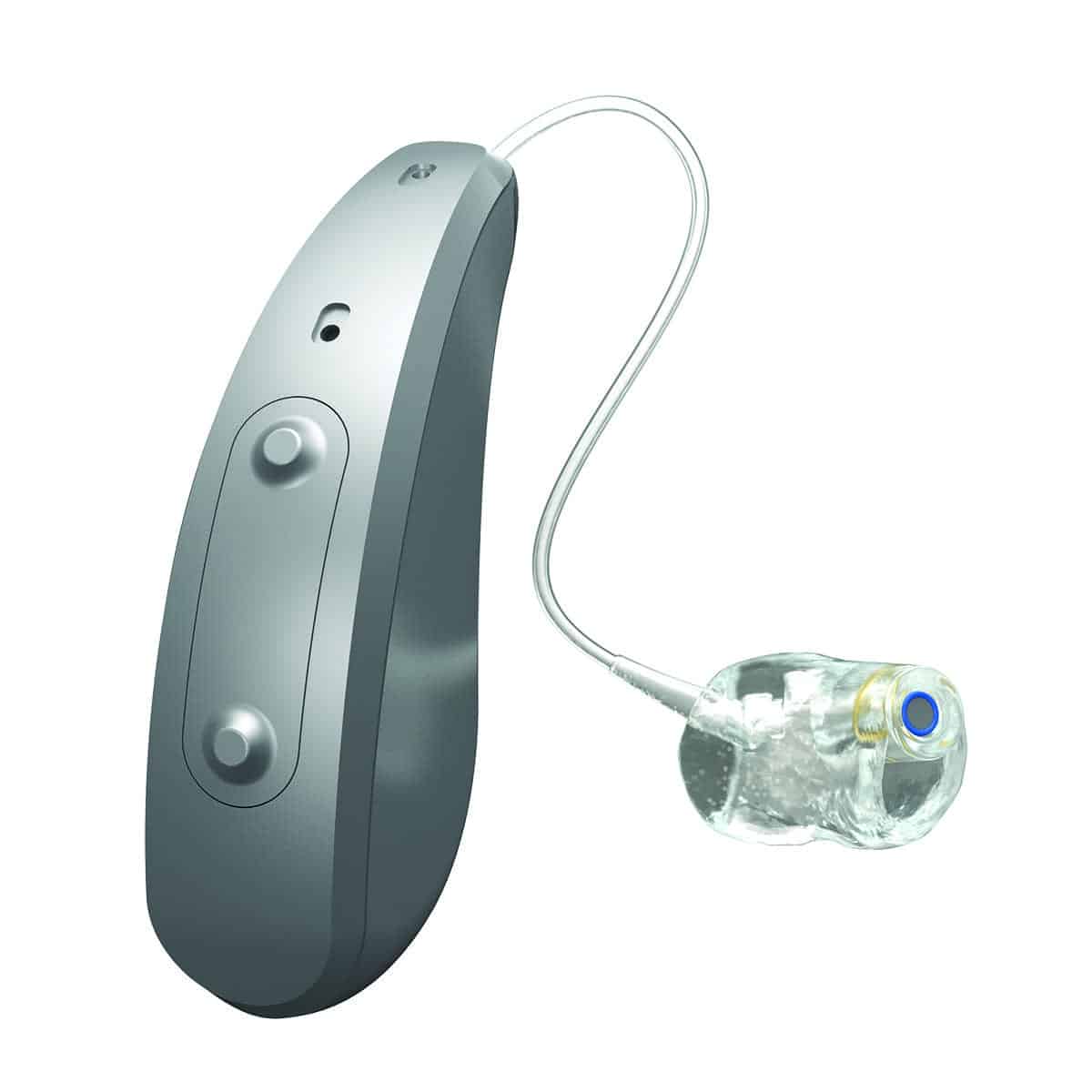Table of Contents
EarLens is a unique hearing aid technology that utilizes a light-based system, as opposed to traditional air or bone conduction, to transmit sound.
Most traditional hearing aids capture sound using a microphone, amplify it, and send it through the ear canal. On the other hand, EarLens uses a different approach. It uses light to transmit sound directly to the eardrum.
Here’s a basic overview of how the EarLens system works:
- Sound Capture: A behind-the-ear (BTE) microphone unit captures sound from the environment, which is then digitally processed.
- Conversion to Light Signals: The BTE unit converts the processed sound into pulses of non-visible light.
- Transmission to the Ear Drum: These light pulses are sent to a custom-made lens (hence the name “EarLens”) that sits directly on the eardrum. The lens is custom-made for each patient to ensure proper fit.
- Sound Perception: The lens vibrates the eardrum directly in response to the light, creating sound waves that the brain perceives.

By vibrating the eardrum directly, EarLens bypasses the natural way that sound is transferred through the outer and middle ear. This allows it to deliver a broader frequency range, enhancing sound quality and clarity.
It’s important to note that while EarLens represents a significant innovation, it may not be the best solution for all types of hearing loss. Anyone considering a hearing aid should consult with an audiologist or other hearing healthcare professional to understand the options and determine the best solution for their specific needs.
Does Insurance cover Earlens?
No, Earlens hearing aids are not covered by Insurance because they classify them as “elective” devices rather than necessary medical equipment. Additionally, high costs (Earlens costs more than $12000) and lack of legislation mandating such coverage also contribute to their exclusion from many health insurance policies.
The Medicare Hearing Aid Coverage Act, or H.R. 244, is a proposed piece of legislation aimed at expanding the coverage provided by Medicare to include hearing aids for beneficiaries who experience hearing loss. If passed, this bill could significantly change the way hearing aids are covered under Medicare. Here’s a detailed explanation:
- Introduction of H.R 244:
- The Medicare Hearing Aid Coverage Act, H.R. 244, was reintroduced to Congress by Debbie Dingell (D-MI) and Brian Fitzpatrick (R-PA) in early 2023.
- This bill’s main aim is to expand Medicare’s coverage to include hearing aids, providing financial assistance to Medicare beneficiaries who suffer from hearing loss and need hearing aids.
- Potential Impact of H.R 244:
- If the bill is passed, it would significantly alter the landscape of hearing aid coverage under Medicare and ensure that Medicare beneficiaries who experience hearing loss have access to the necessary assistive devices.
- According to a 2021 article published in HealthAffairs, this change could impact more than 45 percent of Medicare beneficiaries who report experiencing hearing loss. These individuals could have access to hearing aids through Medicare coverage, reducing out-of-pocket expenses for these necessary devices.
- Importance of H.R 244:
- Hearing loss is a common issue among older people and can significantly impact their quality of life. Providing coverage for hearing aids could dramatically improve the living standards of many Medicare beneficiaries.
- The high cost of hearing aids often prevents individuals from getting the help they need. If this bill is passed, hearing aids will be made more affordable and accessible to many people.
The main reasons why Insurance does not cover Earlens are:
- Classification as “Elective” Devices:
- The insurance industry often classifies hearing aids as “elective” devices. This is because hearing aids, including the Earlens device, are considered beneficial but unnecessary for maintaining a person’s health.
- In many instances, hearing loss is not perceived as life-threatening, so devices that aid hearing are often considered optional or supplementary rather than essential. “Elective” refers to any medical procedure, treatment, or device that is beneficial but not crucial for a person’s survival or primary health. This classification generally includes methods and devices not intended to treat or manage a life-threatening illness or injury.
- High Costs:
- The Earlens hearing aid costs significantly more than other hearing aids, with prices typically exceeding $12,000.
- This high cost presents a financial risk to insurance companies. If they were to cover such expensive devices, they might need to increase premiums for all policyholders to maintain profitability.
- Since insurance companies are for-profit entities, they aim to balance the costs of the services they cover against the premiums they collect. Covering high-cost devices like the Earlens hearing aid could upset this balance.
- Lack of Legislation:
- No federal mandate in the United States requires private health insurance companies to cover hearing aids. The situation might vary in other countries, but such coverage is not legally required in many places.
- Certain states in the U.S. do require insurance companies to provide some degree of hearing aid coverage, but these mandates vary widely, and most have age limits or other restrictions.
- Due to the lack of consistent and comprehensive legislation mandating hearing aid coverage, insurance companies often opt not to cover these devices, including the more expensive Earlens hearing aids.
- Cost-Effectiveness:
- Insurance companies typically cover treatments that they deem cost-effective, meaning the therapy substantially benefits its cost.
- Given the high cost of Earlens hearing aids, insurance companies might determine that the cost outweighs the potential benefits, especially compared to cheaper hearing aids that could provide similar benefits at a lower price.
- Alternative Treatments Available:
- There are alternative, less expensive hearing aids available on the market, which can also significantly improve individuals’ hearing capabilities.
- Insurance companies might argue that these cheaper alternatives are sufficient for treating hearing loss, reducing the need to cover more expensive options like the Earlens hearing aids.
Medicare Advantage plans (Part C) and Hearing Aids
An exception can be for Medicare Advantage plans (Part C), which can cover hearing aids.
Medicare Advantage plans, or Part C, are offered by private insurance companies that Medicare approves. They provide the same coverage as Medicare Parts A and B (Original Medicare) and often offer additional dental, vision, and hearing benefits. Here’s a more detailed look at how this works:
- Enrollment and Coverage:
- Medicare Advantage plans are an alternative to Original Medicare. When you enroll in a Medicare Advantage plan, you’re still in the Medicare program, but your benefits are administered by a private insurance company instead of the federal government.
- These plans are required to cover everything that Original Medicare (Part A and B) covers, which includes hospital insurance (Part A) and medical Insurance (Part B).
- It’s important to note that you still have Medicare if you enroll in a Medicare Advantage Plan. This means you must still pay your monthly Part B premium (and your Part A premium, if you have one).
- Additional Benefits:
- One of the main advantages of Medicare Advantage plans is that they often offer benefits not included in Original Medicare. Additional benefits include prescription drug coverage (Part D) and routine vision, dental, and hearing care.
- Some Medicare Advantage plans offer coverage for hearing aids and related services, like professional fittings and routine exams. However, the extent of this coverage can vary significantly from plan to plan.
- Hearing Care:
- Medicare Advantage plans that include hearing care often cover a variety of services, including diagnostic hearing exams and hearing aids.
- In addition to the device itself, these plans may cover associated services such as professional fittings to ensure the hearing aids are tailored to your specific needs and routine check-ups to monitor your hearing and adjust the device as needed.
- The specific coverage details, including applicable copayments, coinsurance, and deductibles, will depend on your Medicare Advantage plan.
- Choice of Providers:
- Medicare Advantage plans usually have a network of doctors and healthcare providers. You may need to use these network providers to get over your carer. You might have to pay more if you go outside the network.
- Suppose hearing aid coverage is a priority for you. In that case, it’s important to verify not just that a Medicare Advantage plan covers hearing aids but also that it includes a good network of hearing care providers.
Conclusion
Earlen hearing aids are typically not covered by most health insurance plans, including Medicare. The reasons include their classification as “elective” devices, high cost, and lack of legislation requiring insurance companies to cover such devices.
However, insurance coverage can vary widely between providers, plans, and geographical locations, so some private insurance plans or Medicare Advantage may offer some level of coverage for Earlen hearing aids.
Moreover, staying abreast of potential legislative changes is essential, such as the Medicare Hearing Aid Coverage Act (H.R. 244) reintroduced in Congress in 2023. If passed, this bill could expand Medicare coverage to include hearing aids, possibly influencing the policies of private insurance companies as well.
Given the complexities and variability of health insurance policies, anyone seeking coverage for Earlens hearing aids should check directly with their insurance provider or Medicare plan to understand what hearing aid coverage is included.
